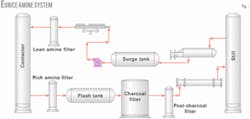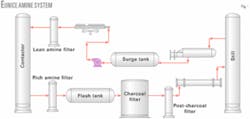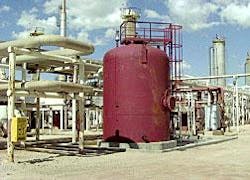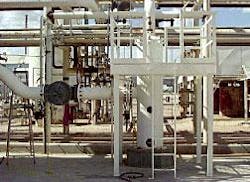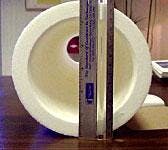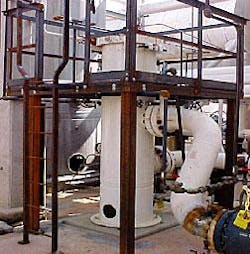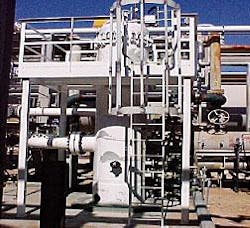Duke Energy Field Services recently added amine filtration devices at its Linam Ranch and Eunice gas processing plants because they were experiencing operating problems due to a lack of amine filtration. The additions included full-flow element filtration on the lean and rich streams of the amine system as well as full-flow charcoal filtration on the rich stream of the system.
The article reviews the plants’ inlet gas treating operations and the problems from ineffective or a lack of amine filtration. The charcoal filter and post- charcoal filters are identical for both facilities.
The filtration projects at the Linam Ranch and Eunice facilities have been in place for more than 2 years and have had positive results in the amine systems and sulfur recovery units (SRU).
The Eunice facility now goes 8-10 weeks between filter changeouts on the lean filter and 6-8 weeks on the rich filter, whereas in the past when the elements were first installed, the filters would plug after a few minutes.
Overview
Inlet gas treating at the Linam Ranch plant in southeastern New Mexico is a monoethanolamine (MEA) system, which operates at 15-19% concentration. It is a low-pressure treater operating at 210 psig with an amine flow rate of about 600 gpm.
The key system components consist of four gas contactors with 1⁄4 of the total inlet volume split to each contactor. The amine regeneration system consists of two stills operated in parallel. The plant was designed to treat 150 MMcfd but has successfully treated up to 180 MMcfd.
Support system components include full-flow filtration on the lean and rich amine streams, which remove large contaminants from the amine solution. The rich amine filter uses 40-µm filters and the lean filter uses 10-µm filters. The filtration systems remove particles from the solution; however, they do not remove aromatics and emulsified contaminants that can carry over into the stills and eventually into the SRU.
Inlet gas treating at Eunice, also in southeastern New Mexico, is a diethanolamine (DEA) based system, which operates at 40% concentration. It is a high-pressure treater operating at 550 psig and an amine flow rate of approximately 570 gpm.
This treater consists of one contactor and one still. The plant was designed to treat 75 MMcfd, but has successfully treated up to 105 MMscfd.
The system was built with a 10% amine side-stream charcoal filter and an element filter downstream of the charcoal filter. The amine system did not have any other source of filtration and the 10% side-stream filter was proving to be inadequate.
Remedies sought
The amine system (Fig. 1) at Eunice was experiencing stacking in the contactor and still, which was associated with hydrocarbons and iron sulfides in the amine solution. The problem is best described by Perry.
He writes, “In a DEA system, where there is little H2S, the entrained iron sulfide is converted back to soluble iron in the still due to essentially complete stripping of H2S from the solution in the still. As the sulfide ions are stripped from the solution, the iron sulfide converts back to soluble iron and hydrogen sulfide. If this soluble iron remains in solution, it will pass through either carbon or mechanical filters and enter the contactor as soluble iron ions, which react with the H2S in the gas forming iron sulfide.
“This precipitates on the trays in the contactor and requires frequent acidizing and cleaning of the contactor. For such installations, it has been found that activated carbon filtration of the rich solution will effectively remove iron sulfide prior to stripping the solution, and will reduce the iron content of the solution to nil, thus eliminating the formation of iron sulfide in the contactor and plugging of the contactor.”1
The Eunice plant experienced four shutdowns in 2001 for cleaning and acidizing the contactor due to the iron sulfide buildup. The amine quality was also very poor with samples usually having a dark green color.
The amine system at Linam Ranch was experiencing minimal stacking in the contactors and stills associated with hydrocarbons in the amine solution. The amine samples were usually green with an occasional oily droplet on top. The main problem at Linam was the hydrocarbon carryover to the SRU.
Tests in spring 2001 showed benzene, toluene, ethylbenzene, and xylene contamination of the acid gas feed stream. The test confirmed significant levels of aromatics in both the acid gas and the converter inlet stream that caused a rapid deactivation of the Claus catalyst. The first catalyst bed of the SRU lasted less than a year and had to be replaced due to the beads being coated with hydrocarbons.
Charcoal filter
The most recent amine system projects included a full-flow charcoal filter at both facilities. The charcoal filter (Fig. 2) was added on the rich amine stream after the flash tank to remove the aromatics and emulsified hydrocarbons.
Amine residence time in the charcoal bed, which was 5-10 min in previous researched articles, is a critical factor in sizing the vessel. The vessel chosen for the plants was 12 ft diameter by 10 ft seam-to-seam with a carbon capacity of 962 cu ft, or about 8.5 ft of the vessel’s height.
The amine has a residence time of about 10-12 min at operational flow rates. This residence time is a key factor because it is critical in obtaining complete removal of the hydrocarbons and a longer bed life.
The charcoal used is Calgon AC-4 mm carbon, which is a strong pellet that produces fewer fines. The support bed is 282 cu ft of No. 4 Anthrafilt support, which is placed in the bottom of the vessel about 6 in. above the outlet screens. The bed support keeps carbon particles from getting through the screens and into the amine stream.
Adding the charcoal filter had immediate positive results. The amine is now clear with no traces of hydrocarbon, the stacking in the contactors has been reduced, and the SRU has seen a dramatic operating improvement. Although the charcoal filter has only been in service for a short time, the results have been good, and the amine analysis has been excellent.
Because the plant is on its first batch of charcoal, the life of the bed has not been proven, but Duke expects the bed to last 9-12 months.
Filter selection
Comparing “apples to apples” is a difficult process when evaluating elements because manufacturers use different measurements, such as beta ratios, efficiencies, and nominal or absolute ratings.
The selection process came down to element cost and “dirt holding capacity.” Overall vessel cost played a minor role in the decision process because the type of filter and element cost will have a much larger impact on future operating budgets.
Some of the other considerations in the element selection were pressure drop across the clean filters and disposal issues. These two items were similar for all elements evaluated; all had low pressure drops and all were coreless filters that could be crushed and easily disposed of with the current plant disposal system.
The goal was to select a filter that would hold a significant amount of dirt for a longer period, experience fewer changeouts, and still be cost effective. A cheap filter that had to be changed out often would not be cost effective nor operationally acceptable and a high-priced element that lasts a few hours due to a shake up of the amine system would also be unacceptable.
We chose a depth-type filter cartridge due to its tapered pore structure, which collects larger particles on the outside and smaller particles more towards the core. This gives the element larger dirt holding capacity and a longer service life.
All of the filters were the same size (6 in. diameter) and type. The micron rating was the only variable for each filter (Fig. 3).
Post-charcoal filter
A post-charcoal filter (Fig. 4) was also installed at both facilities to remove charcoal fines from the charcoal filter.
The filter housing is 24-in. diameter with a quick-opening head and is 6 ft seam-to-seam. The housing contains seven elements rated at 40 µm. The filter vessel has a low pressure drop across the elements, with usually a 1 psi or less pressure drop when first put into service.
The filter housing was placed downstream of the charcoal filter and piped so that the charcoal filter and post filter must be shut down while the elements are replaced. This assures that the element filter is in service while the charcoal filter is in service.
Rich, lean amine filters
Another recent amine system project at the Eunice facility included adding a full-flow rich amine filter and a full-flow lean amine filter (Fig. 5).
The vessels are 24-in. diameter with a “Tubeturn” quick opening head and are 6 ft seam-to-seam. The rich amine filter was installed downstream of the contactor and before the flash tank to filter any contaminants coming from the contactor.
The filter uses seven elements in this service that are 40-µm rated depth elements and are identical to the post-charcoal elements discussed previously. The lean amine filter is a duplicate of the rich amine filter housing but uses 10-µm rated depth elements to catch finer particles that are going to the contactor.
Although the filters have only been in service for a short time, the results have been good, and the amine analysis has been excellent. The plant has been operating smoothly except for occasional small spikes of high pressure drop in the contactor.
Inlet gas coalescer
The inlet-gas coalescer (Fig. 6) was the final item placed in service at the Eunice facility. The existing horizontal inlet gas filter-separator was undersized and in poor mechanical shape. A new inlet gas coalescer was put in series with the existing unit to allow the horizontal separator to work as a bulk knockout. The second vertical unit removes finer aerosols that were contaminating the amine system.
The vertical unit was sized to work without the horizontal unit so that each unit could be shut down individually for filter changeouts. The vertical inlet coalescer is 36-in. diameter with a quick opening head and is 127 in. seam-to-seam.
The inlet coalescer uses 29 coreless elements that are 4.5-in. diameter with an inside to outside flow. The elements should only be changed out once or twice a year; therefore, the cost of the elements was not as critical as the amine filters.
The inlet gas coalescer has only been in service a few weeks, but has eliminated the high delta pressure spikes that occurred in the contactor.
Filter performance
The filtration projects at the Linam Ranch and Eunice plants have been in place for more than 2 years and have had positive results in the amine systems and the SRU. These projects have removed contaminants that were affecting the operations, causing downtimes, and increasing maintenance costs.
Even though the elements in the filters initially lasted only minutes when first put into service, the Eunice plant now goes 8-10 weeks between filter changeouts on the lean filter and 6-8 weeks on the rich filter.
The Eunice plant has not experienced any shutdowns due to cleaning or acidizing of the amine system since the filters were installed. As more run time with the filters in service occurs, the facilities have seen the benefits of the installation through smoother operations and reduced maintenance costs.
The amine has also become clear with no traces of hydrocarbon. In fact, one operator was concerned about amine quality because the solution is now water white. ✦
Acknowledgments
The author thanks Glenn Wood and Clint Richardson of Hatfield (Nowata Filters), Dave Walker of Coastal Chemical, Ronnie Oster of Metron (PALL Filters), and David Wisdom of Wisdom Engineering for providing information for this article.
Reference
1. Perry, C.R., “Activated Carbon Filtration of Amine and Glycol Solutions,” presented to the Laurance Reid Gas Conditioning Conference, Norman, Okla., March 1974.
The author
Von McCallum is the western region director of technical operations for Duke Energy Field Services, Midland, Tex. He served as the asset engineer for the Linam Ranch and Eunice gas plants before moving into his current position. McCallum previously held positions with ABB Lummus Global, Houston, and at General Tire Inc.’s synthetic rubber plant, Odessa, Tex. He holds a BS (1989) in mechanical engineering from Texas A&M University and an MBA (1996) from the University of Texas, Permian Basin.
